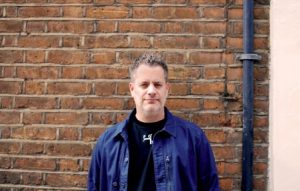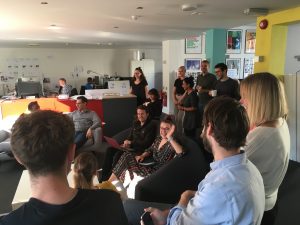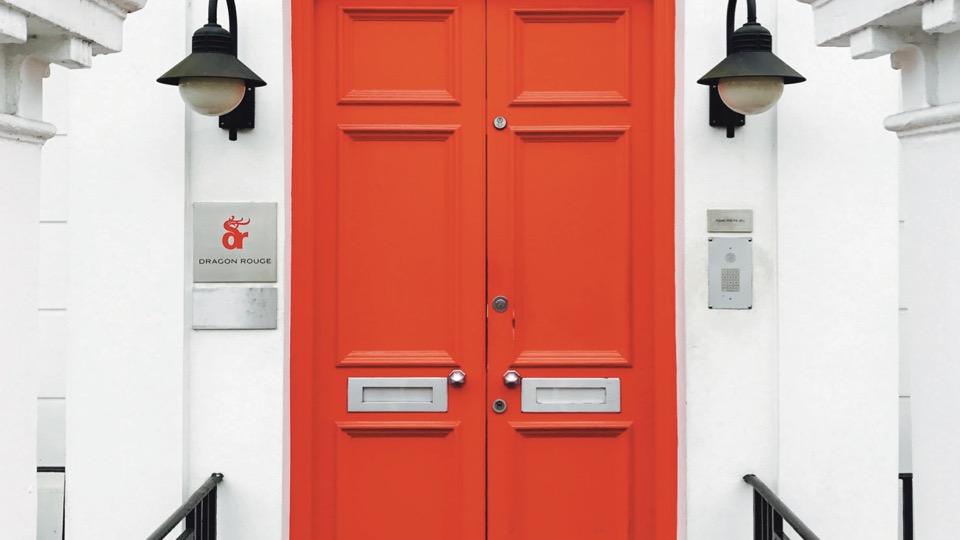Main Content

The DBA Interviews… David Beare, Executive Creative Director, Dragon Rouge London
By Hannah Paterson, Insight & Content Editor, DBA
“As a business, investing time in our people is probably more important than anything else. Ultimately it’s our people that drive our culture and our success.”
DBA member, Dragon Rouge is a global creative agency with offices in Paris, London, Hamburg, Warsaw, Shanghai, Singapore, Sao Paulo and New York. Having recently taken over the creative helm at the agency’s London office after seven years at the business, David Beare shares valuable insight into leading and nurturing talent.
What’s your golden rule?
David: “Listen. No, really listen. And don’t be afraid to ask questions.”
 How do you cultivate those traits within your team?
How do you cultivate those traits within your team?
David: “Listening is a real skill. In my experience, a majority of people are very good at saying they have listened – they nod and smile and convey all the right body language. But the reality is often very different. Many people come to conversations with agendas, whether that is to make themselves be heard or to make themselves not be heard, and escape the conversation altogether. When I started out in our industry, I was very much an introvert and would quite often opt for the latter.
Listening requires us to put our undivided attention, interest or heart into a conversation. Now I can’t force my team to do this, but there are certain things I can do to help them. Conversations need to be clear, concise and delivered in a memorable and engaging manner. This might involve using visual prompts, metaphors and even repeating the same information but in a more tangible or visual way – and in turn, this makes the content more sticky and memorable.
Ultimately I want my team to not only listen but to understand. So this is when asking questions becomes incredibly important. Questions are for clarification, or for further explanation. We’ve all been in meetings where we’ve listened very carefully, leave the meeting and then say to ourselves ‘why didn’t I ask what x, y and z meant?’
Asking the right questions is a combination of confidence and experience. I try to create an environment where my team feel free to ask questions without prejudice. I want my team to challenge me by asking questions, and I’ll also ask questions of them to ensure they have understood the conversation. Finally, I always ask that my team bring a pen and paper to a meeting – taking notes is still, for me, one of the best ways to ensure you’ve captured a conversation – it’s something you can refer back to after a meeting and even follow up on with further questions.”
In your early career, is there a question you wish you’d learnt to, or had the courage to, ask sooner?
David: “It would have to be ‘What does that mean?’ There were so many times that I would leave a meeting and pretend I’d understood an acronym or a marketing phrase because of my unfounded fear of looking stupid. But I very quickly realised that it was a far better approach to ask the questions rather than suffering in silence.”
 As a leader, what is key to helping someone realise their potential?
As a leader, what is key to helping someone realise their potential?
David: “There’s a great quote from the former CEO of General Electric that sums this question up perfectly:
“Before you are a leader, success is all about growing yourself. When you become a leader, success is all about growing others.”
To realise potential, you have to be able to recognise potential. So first and foremost, it’s about looking at people as individuals. One size certainly doesn’t fit all when it comes to helping somebody realise their potential. Every employee is different, with their own set of experiences, values, cultural backgrounds, influences and beliefs. Getting to understand this is of critical importance.
I look to learn what an individual’s strengths and weaknesses are and then work on a plan to develop both. The strengths are probably the reason I hired them in the first place, and these are the things that will have been considered as part of building a diverse team that can learn from one another and contribute to the greater whole. For me, developing an individual comes down to a combination of the following:
– Creating quality time and space for feedback and direction
– Pushing them out of their comfort zone
– Using failure as a learning opportunity
– Maintaining an open-door policy
– Offering ongoing performance reviews and training
– Encouraging individuality
– And never allowing complacency
Personally, there is nothing more rewarding than seeing somebody realise their potential. As a business, investing time in our people is probably more important than anything else. Ultimately it’s our people that drive our culture and our success.”
What’s the most effective way to give feedback?
David: “Feedback can work in several ways. It can be on a very informal basis where I might be walking around the studio and catching up with the team, it might be an unplanned ‘could you just have a quick look at this’, or it might be the more formal side of things where we arrange team catch-ups or one on one reviews.
The most effective of these would have to be the one on one time. In these situations, I often find my team to be much more open and honest. When providing feedback, I aim to ensure it’s clear, concise and constructive. I also think a healthy dose of honesty goes a long way. This means avoiding the sh*t sandwich, which is typically a positive opening followed by the feedback you really need to give and then to end the conversation on something positive again. Experience has taught me to focus on the feedback you really need to provide. Feedback is also about praise – building my team’s confidence and helping individuals grow from a healthy balance of all these things.”
How does an Executive Creative Director role differ from the role of Creative Director?
David: “Broadly speaking, the ECD role means I’m leading the creative output across departments, shaping the agency culture, taking responsibility for hiring and building the perception of the agency externally. It’s about heading up pitches, sharing all the tricks and tips I’ve gathered over the years and helping people do the best work they can. It’s about protecting the creative team and their creative product. It’s about creating a space where creativity can flourish and it’s about building our creative reputation. This is a much bigger and broader role than that of a Creative Director, but it’s something I couldn’t do without the Creative Directors and the wider team. Working closely with them all and empowering them to make decisions ensures I create the space and the time to focus on the big picture.
My new role also extends beyond London to working with the Dragon Rouge group where I’ll be looking to learn from other offices and bring this learning back to the London office – equally I’ll be taking what we’re doing in London out to these offices and hopefully giving them a fresh perspective on things. Ultimately, this should help align and improve our creative product and process and offer up new ways to collaborate and share expertise.
The other difference – more meetings. As a consequence, I do have much less time to be hands-on, but where I can, I do still like to roll my sleeves up and get involved. It keeps me close to the product and the team which is of vital importance.”
What business expression do you most dislike?
David: “Those dreaded emails that start FYI – you know the ones I mean – the ones where you’re going to have to spend the next hour working through forwarded emails to find that elusive piece of useful information.”
What’s the smartest business idea you’ve ever had?
David: “It would have to be taking on the opportunity to set up, from scratch, an in-house branding and design team for a drinks business. It seemed scary and slightly crazy at first, but it introduced me to a whole new side of the industry – more from a business perspective than just a creative one. If you’re a creative then you quite often get stuck in a very singular rut of working for a design, branding or advertising agency without ever seeing how things work from a client’s perspective. This was a real deep dive into this world and it’s made me much more empathetic and sympathetic to the day to day demands that our clients face.”
Which leader do you admire most and why?
Sir Ken Robinson. Why? Just watch his TED talk ‘Do schools kill creativity?‘
What drew you to a career in design?
David: “I grew up with the dream of one day being an architect. I used to love spending hours studying the work of Antoni Gaudì, Frank Lloyd Wright, Le Corbusier, Rem Koolhaas and Oscar Niemeyer (to name just a few). So when I was offered a six-week placement at a local architects firm, while studying my GCSEs, I jumped at the opportunity. Unfortunately, my experience was about as far removed from my dream as I could imagine. The reality of each day was endless tea making, photocopying, and running to the shops to buy lunch for the team. Add to that being told how hard it was to make it as an architect and my dream of designing the next Guggenheim was slowly being crushed. But all was not lost. As I moved closer to deciding on which degree to do, I discovered something called graphic design. It seemed to marry the geometric sensibilities of architecture with something more expressive and artistic, and as they say, the rest is history.”
And looking ahead; what’s exciting you about your role and about the future of design?
David: “With my new role it’s about being able to influence the business at every level through the lens of creativity. So it’s not just about creative output; it’s about using creativity to solve more significant business problems, to help shape the future direction of the business and to ensure we remain relevant and at the forefront of an increasingly competitive and demanding industry.
As for the future – well, this is my 20th year in the industry, and I’ve seen an enormous amount of change. Moving forward, I can only see the next 20 years presenting an even greater level of change and in turn, some exciting new challenges. This change will provide us with even more exciting opportunities for creativity to become the primary driver of growth and in turn, success for our clients and for us. The currency of ideas will always hold their value. And this is what our clients and we are going to need much, much more of in the future. Now that has to be exciting for all of us.”
Image credits:
Valdemaras D. | Unsplash
Dragon Rouge

About: Dragon Rouge
Dragon Rouge is the largest independent and global full service ‘end to end’ agency with eight offices in four continents. Foresight and insight are at our core, fuelling stand-out innovation, design and activation. Working for brands and businesses from B2C to B2B in multiple channels, we bring perception, anticipation and imagination together to create brands with momentum for brand owners with big ambitions.
David Beare, Dragon Rouge London’s Executive Creative Director, has over 20 years experience in branding agencies, advertising agencies, and in house with clients. This puts him in a perfect position to develop world class, award-winning creative solutions. He enjoys working with clients of all shapes, sizes and market scopes. Clients he has worked with include Nike, Diageo, Unilever, Vodafone and Universal Music.

 How do you cultivate those traits within your team?
How do you cultivate those traits within your team? As a leader, what is key to helping someone realise their potential?
As a leader, what is key to helping someone realise their potential?